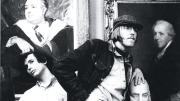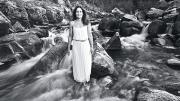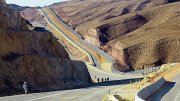As a newly minted Harvard Crimson photographer, Timothy G. Carlson ’71 made his way into University Hall on April 9, 1969, during its occupation by student protesters. Four of his almost elegiac black-and-white photographs from that day, of the protesters meeting in a sunlit hall and of the violent nighttime police bust that ended the occupation, appeared in Life magazine, a pair of them as two-page spreads.
That portfolio gained Carlson admission to Harvard’s visual and environmental studies department, where his senior thesis was a photo essay on his hometown, Daytona Beach, Florida. The work of legendary photojournalists like Henri Cartier-Bresson, Robert Frank, Margaret Bourke-White, and Walker Evans helped shape his photographic vision: Frank’s irony and Cartier-Bresson’s geometric compositions in particular informed Carlson’s early images.
Eventually he reached his own understanding of “the decisive moment”—a phrase popularized as the English title of Cartier-Bresson’s classic 1952 book of photographs, Images à la Sauvette (“images on the run” or “stolen images”). “There is a creative fraction of a second when you are taking a picture,” Cartier-Bresson told The Washington Post in 1957. “Your eye must see a composition or an expression that life itself offers you, and you must know with intuition when to click the camera. That is the moment the photographer is creative. ‘Oop! The Moment!’ Once you miss it, it is gone forever.” For Carlson, though, the “decisive moment” has not been something to take literally. “It was something surprising or wonderful or alive,” he says, “in which you placed a person or object in the middle of life or a culture, in a balanced arrangement of forms that created its own logic.”
Carlson traveled and photographed extensively in the United States after graduation, before going to Lebanon in 1974 to document a group of Palestinians living there. But his plan to photograph the civil war in nearby Cyprus collapsed, and a severe gastrointestinal disorder finished off his career as an itinerant photographer. Since then, he has made his living primarily as a writer for mainstream and specialty publications, including the Los Angeles Herald and TV Guide. But he has never put down his camera, and his photographic style has evolved across the decades.
For the past 20 years, Carlson has focused on triathlons and the extraordinary athletes who compete in them, publishing many photographs in the specialized magazines and online media that cover the sport (see https://www.flickr.com/photos/timothycarlsonphotography/sets). Many of his images embed the human subjects in an almost overpowering natural setting. For example, a 2012 portrait of retired professional triathlete Eney Jones poses her in a white evening dress, standing with precarious grace on a rock amid a rushing river, setting up a riveting dynamic tension. A 2014 photograph from Israel’s Eilat triathlon shows a string of Lilliputian cyclists racing on a paved road that turns and twists through hilly desert.
Though he traces his photographic roots to the days of darkrooms and silver salts, Carlson has enthusiastically embraced modern photographic technology. “I’m grateful for the mature digital age,” he says of the modern high-end digital cameras that produce brilliant color and razor-sharp resolution. He has also taken to artificially lighting his subjects, or combining natural and artificial light sources in the same photograph. “I was seduced by, and fell in love with, the diffuse light of light boxes,” and began using it for portraits of certain people, he explains, citing the influence of Annie Leibovitz. Carlson’s 2012 portrait of a swimmer emerging from the water is arresting. The spray of water droplets—frozen in time against an impossibly blue sky by the strobe in the light box—gives the image an instantaneous quality, while a modest tilt of the horizon creates a degree of compositional tension.
Carlson still returns periodically to Daytona Beach to photograph and has no plans to put down his camera. He regrets never having done the depth of photo-journalistic reportage that characterizes some of the photographers who inspired him. But when pressed, he admits that he finds some of his own individual images “worthy.”











